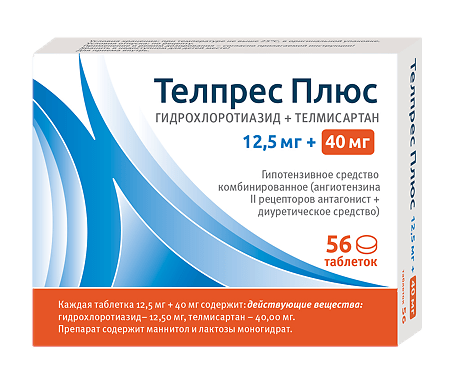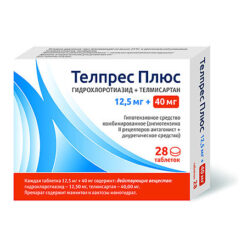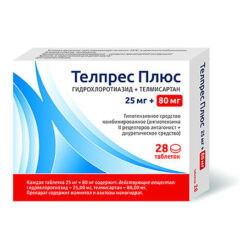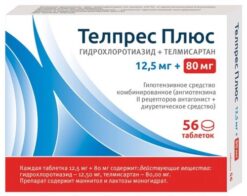Subtotal: €33.00
Telprez Plus, tablets 40 mg+12, 5 mg 56 pcs
€18.12 €15.10
Out of stock
(E-mail when Stock is available)
Hypertension (high blood pressure)
Indications
Arterial hypertension (if telmisartan or hydrochlorothiazide is ineffective as monotherapy).
Pharmacological effect
Pharmacotherapeutic group: Antihypertensive combined drug (angiotensin II receptor blocker + diuretic)
Pharmacological action
A combined antihypertensive drug that includes the angiotensin II receptor antagonist telmisartan and the thiazide diuretic hydrochlorothiazide. The simultaneous use of these components leads to a more pronounced antihypertensive effect than the use of each of them separately.
Telmisartan is a specific angiotensin II receptor antagonist. It has a high affinity for the AT1 receptor subtype of angiotensin II, through which the action of angiotensin II is realized. Telmisartan displaces angiotensin II from binding to the receptor without having an agonist effect on this receptor. Telmisartan binds only to the AT1 receptor subtype of angiotensin II. The binding is long lasting. Telmisartan has no affinity for other receptors (including AT2 receptors) of angiotensin. The functional significance of these receptors, as well as the effect of their possible excessive stimulation by angiotensin II, the concentration of which increases with the administration of telmisartan, have not been studied. Telmisartan leads to a decrease in the concentration of aldosterone in the blood, does not inhibit renin in the blood plasma and does not block ion channels. Telmisartan does not inhibit ACE (kininase II), an enzyme that also breaks down bradykinin, so an increase in bradykinin-induced side effects is not expected.
In patients with arterial hypertension, telmisartan at a dose of 80 mg completely blocks the hypertensive effect of angiotensin II. The onset of antihypertensive action is observed within 3 hours after the first oral administration of telmisartan. The effect lasts for 24 hours and remains significant for up to 48 hours. A pronounced antihypertensive effect usually develops after 4 weeks of regular use.
In patients with arterial hypertension, telmisartan reduces systolic and diastolic blood pressure without affecting heart rate.
In case of abrupt withdrawal of telmisartan, blood pressure gradually returns to baseline without the development of withdrawal syndrome.
Hydrochlorothiazide is a thiazide diuretic, the diuretic effect of which is associated with impaired reabsorption of sodium, chlorine, potassium, magnesium, and water ions in the distal nephron; delays the excretion of calcium ions and uric acid. Has antihypertensive properties; the hypotensive effect develops due to the expansion of arterioles. Has virtually no effect on normal blood pressure levels.
The removal of electrolytes and water begins approximately 2 hours after administration, the maximum effect is achieved within 3-6 hours and lasts for 6-12 hours. The antihypertensive effect is achieved within 3-4 days of treatment and lasts for 1 week after completion of the drug. With long-term treatment, a decrease in blood pressure is achieved by using lower doses than those required for a diuretic effect. The decrease in blood pressure is accompanied by a slight increase in glomerular filtration rate, renal vascular resistance and renin activity in the blood plasma.
Hydrochlorothiazide, when taken once in high doses, leads to a decrease in plasma volume, glomerular filtration rate, renal blood flow and mean blood pressure. With long-term use in small doses, blood plasma volume remains reduced, while minute volume and glomerular filtration rate return to the initial level prior to the start of treatment. Mean blood pressure and systemic vascular resistance remain reduced. Thiazide diuretics may interfere with breast milk production.
The maximum antihypertensive effect of the combination of telmisartan + hydrochlorothiazide is usually achieved 4-8 weeks after the start of treatment.
Pharmacokinetics
The simultaneous use of hydrochlorothiazide and telmisartan does not affect the pharmacokinetics of each of the components of the drug.
Telmisartan
When taken orally, it is quickly absorbed from the gastrointestinal tract. Bioavailability – approximately 50%. Cmax of telmisartan is achieved within 0.5-1.5 hours after administration. When taken simultaneously with food, the reduction in AUC ranges from 6% (when used at a dose of 40 mg) to 19% (when used at a dose of 160 mg). 3 hours after oral administration, the concentration in the blood plasma levels off, regardless of food intake. Binding to blood plasma proteins is significant (more than 99.5%), mainly to albumin and α1-glycoprotein. Vd approximately 500 l. Telmisartan is metabolized by conjugation with glucuronic acid. Metabolites are pharmacologically inactive. T1/2 is more than 20 hours. It is excreted unchanged through the intestines, excretion by the kidneys is less than 2%. The total plasma clearance is high (about 900 ml/min).
Pharmacokinetic studies in patients with liver failure showed an increase in absolute bioavailability to almost 100%. In liver failure, T1/2 does not change.
Hydrochlorothiazide
After oral administration, Cmax of hydrochlorothiazide is achieved within 1-3 hours. Absolute bioavailability is assessed by the cumulative renal excretion of hydrochlorothiazide and is about 60%. Plasma protein binding is 40-70%. Vd – 0.8±0.3 l/kg. It is not metabolized in the human body and is excreted in urine almost unchanged. About 60% of the dose taken orally is excreted within 48 hours. Renal clearance is about 250-300 ml/min. T1/2 – 10-15 hours. There is a difference in plasma concentrations in men and women. In women, there is a tendency to a clinically significant increase in the plasma concentration of hydrochlorothiazide. In patients with impaired renal function, the rate of elimination of hydrochlorothiazide is reduced. Studies conducted in patients with CC 90 ml/min showed that T1/2 of hydrochlorothiazide increases. In patients with reduced renal function, T1/2 is about 34 hours.
Special instructions
In some patients, due to suppression of the activity of the RAAS, especially with the simultaneous administration of drugs acting on this system, renal function is impaired (including acute renal failure). Therefore, therapy accompanied by such a double blockade of the RAAS (for example, when adding an ACE inhibitor or a direct renin inhibitor – aliskiren to angiotensin II receptor antagonist blockers) should be carried out strictly individually and with regular monitoring of renal function (including periodic monitoring of potassium and creatinine in the blood serum).
The use of thiazide diuretics in patients with impaired renal function can lead to azotemia. Periodic monitoring of renal function is recommended.
In patients with bilateral renal artery stenosis or arterial stenosis of a single functioning kidney, when using medications that affect the RAAS, the risk of developing severe arterial hypotension and renal failure increases.
In patients with impaired liver function or progressive liver disease, this combination should be used with caution, since even slight changes in water and electrolyte balance may contribute to the development of hepatic coma.
In patients with diabetes mellitus, changes in the dose of insulin or oral hypoglycemic agents may be required. During therapy with thiazide diuretics, manifestation of latent diabetes mellitus is possible.
In some cases, when using thiazide diuretics, hyperuricemia and exacerbation of gout may develop.
In patients with diabetes mellitus and additional cardiovascular risk, such as patients with diabetes mellitus and coronary artery disease, the risk of fatal myocardial infarction and sudden cardiovascular death may be increased when taking blood pressure-lowering drugs such as angiotensin II receptor antagonists or ACE inhibitors. In patients with diabetes mellitus, CAD may be asymptomatic and therefore may be undiagnosed. Before using this combination to identify and treat coronary artery disease, appropriate diagnostic studies should be carried out, incl. exercise test.
Hydrochlorothiazide, being a sulfonamide derivative, can cause an idiosyncratic reaction in the form of acute transient myopia and acute angle-closure glaucoma. Symptoms of these disorders include a sudden decrease in visual acuity or eye pain, which typically occurs within a few hours to several weeks after starting to use the drug. If left untreated, acute angle-closure glaucoma can lead to vision loss. The main treatment is to discontinue hydrochlorothiazide as quickly as possible. It is important to keep in mind that if intraocular pressure remains uncontrolled, emergency medical or surgical treatment may be required. Risk factors for the development of acute angle-closure glaucoma include a history of allergies to sulfonamides or penicillin.
Thiazide diuretics, incl. hydrochlorothiazide may cause disturbances in water-electrolyte balance and acid-base status (hypokalemia, hyponatremia and hypochloremic alkalosis). Warning signs for these disorders are dryness of the oral mucosa, a feeling of thirst, general weakness, drowsiness, anxiety, myalgia or convulsive twitching of the calf muscles (cramps), muscle weakness, a marked decrease in blood pressure, oliguria, tachycardia and gastrointestinal disorders such as nausea or vomiting. During treatment with this combination, periodic monitoring of the content of electrolytes in the blood serum is necessary.
When using this combination, the risk of hypokalemia is more likely in patients with cirrhosis of the liver, with increased diuresis, while following a salt-free diet, as well as in the case of simultaneous use of gluco- and mineralocorticoids or corticotropin; Risk factors for hyperkalemia include renal and/or heart failure and diabetes mellitus.
Thiazide diuretics can reduce the excretion of calcium by the kidneys and cause (in the absence of obvious disturbances in calcium metabolism) a transient and slight increase in serum calcium. More severe hypercalcemia may be a sign of hidden hyperparathyroidism. Thiazide diuretics should be discontinued before assessing parathyroid function.
Thiazide diuretics have been shown to increase renal excretion of magnesium, which may lead to hypomagnesemia.
In patients with coronary artery disease, the use of any antihypertensive drug, in case of excessive reduction in blood pressure, can lead to myocardial infarction or stroke.
Impact on the ability to drive vehicles and machinery
During treatment, the possibility of dizziness and drowsiness should be taken into account, which requires caution.
Active ingredient
Hydrochlorothiazide, Telmisartan
Composition
Active substances
hydrochlorothiazide
telmisartan
Excipients: mannitol – 163.85 mg, povidone K25 – 10.8 mg, crospovidone – 6 mg, magnesium stearate – 4.5 mg, meglumine – 12 mg, sodium hydroxide – 3.35 mg, lactose monohydrate – 49.84 mg, microcrystalline cellulose – 32 mg, hypromellose – 3 mg, sodium carboxymethyl starch (type A) – 2 mg, iron oxide yellow (E172) – 0.17 mg.
Contraindications
Obstructive diseases of the biliary tract; severe liver dysfunction (class C on the Child-Pugh scale); severe renal dysfunction (creatinine clearance <30 ml/min); refractory hypokalemia, hypercalcemia; simultaneous use with aliskiren in patients with diabetes mellitus and renal failure (GFR < 60 ml/min/1.73 m2); age under 18 years; pregnancy; lactation period (breastfeeding) hypersensitivity to telmisartan, hydrochlorothiazide or other sulfonamide derivatives.With caution: bilateral renal artery stenosis or stenosis of the artery of a single kidney; impaired liver function or progressive liver disease (class A and B on the Child-Pugh scale); decrease in blood volume due to previous diuretic therapy, restriction of salt intake, diarrhea or vomiting; hyperkalemia; condition after kidney transplantation (no experience of use); chronic heart failure FC III-IV according to the NYHA classification; stenosis of the aortic and mitral valve; idiopathic hypertrophic subaortic stenosis; hypertrophic obstructive cardiomyopathy; diabetes mellitus; primary aldosteronism; gout; closed-angle glaucoma (due to the presence of hydrochlorothiazide in the composition).
Side Effects
From the respiratory system: respiratory distress syndrome (including pneumonia and pulmonary edema), shortness of breath.
From the cardiovascular system: arrhythmias, tachycardia, bradycardia, marked decrease in blood pressure (including orthostatic hypotension).
From the nervous system: syncope/fainting, paresthesia, sleep disturbances, insomnia, dizziness, anxiety, depression, increased excitability, headache.
From the digestive system: diarrhea, dry oral mucosa, flatulence, abdominal pain, constipation, vomiting, gastritis, loss of appetite, anorexia, hyperglycemia, hypercholesterolemia, pancreatitis, liver dysfunction, jaundice (hepatocellular or cholestatic), dyspepsia.
From the skin: increased sweating.
From the musculoskeletal system: back pain, muscle spasms, myalgia, arthralgia, calf muscle cramps, arthrosis, tendonitis-like symptoms, chest pain.
From the hematopoietic system: iron deficiency anemia, aplastic anemia, hemolytic anemia, thrombocytopenia, eosinophilia, leukopenia, neutropenia/agranulocytosis, thrombocytopenia.
From the urinary system: renal failure, including acute renal failure, interstitial nephritis, glycosuria.
From the senses: visual impairment, transient blurred vision, xanthopsia, acute angle-closure glaucoma, acute myopia.
From the reproductive system: impotence.
Infections: sepsis, including fatal cases, upper respiratory tract infections (bronchitis, pharyngitis, sinusitis), urinary tract infections (including cystitis), inflammation of the salivary glands.
From the metabolic side: increased concentration of creatinine in the blood plasma, increased activity of liver enzymes, increased activity of CPK, increased concentration of blood uric acid, hypertriglyceridemia, hypokalemia, hyperkalemia, hyponatremia, hyperuricemia, decreased blood volume, hypoglycemia (in patients with diabetes), impaired glucose tolerance, decreased hemoglobin level in the blood.
Allergic reactions: angioedema (including fatal cases), erythema, pruritus, rash, anaphylactic reactions, eczema, drug rash, toxic epidermal necrolysis, lupus-like reactions, exacerbation or intensification of symptoms of systemic lupus erythematosus, necrotizing vasculitis, systemic vasculitis, photosensitivity reaction, relapse of systemic lupus erythematosus, vasculitis.
Other: flu-like syndrome, fever, weakness.
Interaction
Telmisartan
Other antihypertensive drugs – may enhance the hypotensive effect.
Lithium preparations – a reversible increase in the concentration of lithium in the blood, accompanied by toxic effects, has rarely been observed. When using lithium preparations and angiotensin II receptor antagonists simultaneously, it is recommended to determine the lithium content in the blood;
NSAIDs, including acetylsalicylic acid in doses used as an anti-inflammatory agent, COX-2 inhibitors and non-selective NSAIDs – acute renal failure may develop in patients with reduced BCC. Drugs that affect the RAAS may have a synergistic effect. In patients receiving NSAIDs and telmisartan, at the beginning of treatment, volumetric volume should be compensated and renal function testing should be performed. A decrease in the effect of antihypertensive agents such as telmisartan, through inhibition of the vasodilatory effect of prostaglandins, has been observed when combined with NSAIDs. When telmisartan was used simultaneously with ibuprofen or paracetamol, no clinically significant effect was observed.
Digoxin – an increase in the average concentration of digoxin in the blood plasma was noted by an average of 20% (in one case by 39%). When telmisartan and digoxin are prescribed simultaneously, it is advisable to periodically determine the concentration of digoxin in the blood.
Hydrochlorothiazide
Ethanol, barbiturates, opioid analgesics – risk of developing orthostatic hypotension.
Oral hypoglycemic agents and insulin – Dosage adjustments of oral hypoglycemic agents and insulin may be required.
Metformin – there is a risk of developing lactic acidosis.
Cholestyramine and colestipol – in the presence of anion exchange resins, the absorption of hydrochlorothiazide is impaired.
Cardiac glycosides – increases the risk of developing hypokalemia or hypomagnesemia caused by thiazide diuretics, developing arrhythmias caused by cardiac glycosides.
Pressor amines (for example, norepinephrine) – the effect of pressor amines may be weakened.
Non-depolarizing muscle relaxants (for example, tubocurarine chloride) – hydrochlorothiazide may enhance the effect of non-depolarizing muscle relaxants;
Antigout drugs – the concentration of uric acid in the blood serum may increase, so changes in the dose of uricosuric drugs may be required. The use of thiazide diuretics increases the incidence of hypersensitivity reactions to allopurinol.
Calcium preparations – thiazide diuretics can increase the calcium level in the blood serum due to a decrease in its excretion by the kidneys. If you need to use calcium supplements, you should regularly monitor the calcium level in the blood and, if necessary, change the dose of calcium supplements.
Beta blockers and diazoxide – Thiazide diuretics may potentiate the hyperglycemia caused by beta blockers and diazoxide;
M-anticholinergics (for example, atropine, biperidine) – decrease gastrointestinal motility, increase the bioavailability of thiazide diuretics.
Amantadine – Thiazide diuretics may increase the risk of side effects caused by amantadine.
Cytotoxic drugs (for example, cyclophosphamide, methotrexate) – decrease the renal excretion of cytotoxic drugs and enhance their myelosuppressive effect.
NSAIDs – combined use with thiazide diuretics can lead to a decrease in diuretic and antihypertensive effect.
Drugs that lead to the excretion of potassium and hypokalemia (for example, diuretics that remove potassium, laxatives; gluco- and mineralocorticoids; corticotropin; amphotericin B; carbenoxolone; benzylpenicillin, acetylsalicylic acid derivatives) – enhance the hypokalemic effect. Hypokalemia caused by hydrochlorothiazide is compensated by the potassium-sparing effect of telmisartan.
Potassium-sparing diuretics, potassium preparations, other drugs that can increase the potassium content in the blood serum (for example, heparin) or replacing sodium in table salt with potassium salts – the development of hyperkalemia is possible. Periodic monitoring of the potassium level in the blood plasma is recommended in cases where the combination of telmisartan + hydrochlorothiazide is used simultaneously with drugs that can cause hypokalemia, as well as with drugs that can increase the level of potassium in the blood serum.
Manufacturer
Laboratorios Likonsa S.A., Spain
| Manufacturer | Laboratorios Liconza S.A., Spain |
|---|---|
| Medication form | pills |
| Brand | Laboratorios Liconza S.A. |
Other forms…
Related products
Buy Telprez Plus, tablets 40 mg+12, 5 mg 56 pcs with delivery to USA, UK, Europe and over 120 other countries.




















